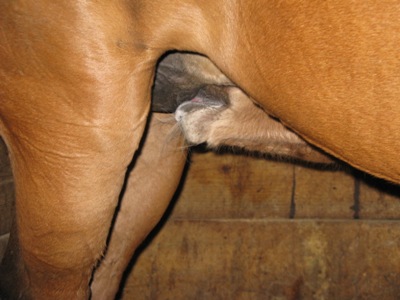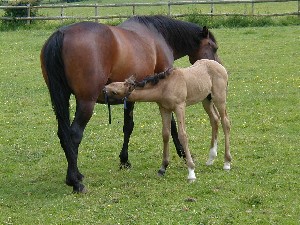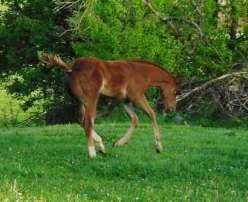A newborn foal is one of the most anticipated and exciting occurrences in the horse industry. Actually, the entire industry revolves around this single event. The next generation of performance champions and the future sires and dams of each breed are born each spring.
The breeder invests considerable time, money and endeavor in each foal. The long gestation period of 335 – 340 days greatly adds to the anticipation of each new foal.
Newborn foals must be given correct care to insure they grow and develop properly, reaching their genetic and economic potential.
Pre-Foaling Preparation
Broodmares should be vaccinated 30 days before foaling and also placed in the environment where they will foal. Since foals are born without any immunity, both practices help protect the newborn foal from diseases. They acquire immunity from antibodies in the colostrum, the first milk. Failure to get these antibodies greatly increases the risk of disease and possibly death.
The typical diseases mares are vaccinated for are tetanus, Eastern and Western Equine Encephalomyelitis, influenza and West Nile Virus. (See West Nile Virus story). Your veterinarian may recommend others. It is also important that the foaling stall be properly disinfected before foaling.
Newborn Foal Care
It is advisable to allow the mare and foal to lie quietly for 10 – 20 minutes after birth. It is also important to allow the mare to get up and smell the foal, which is part of the foal identification process.
It is critical that foals breathe after birth. If necessary, remove the amnion (clear, transparent tissue) from the foal’s head. Clean any mucus out of its nostrils by gently pressing your thumb and forefinger along the top of the nostrils toward the muzzle, like squeezing a toothpaste tube. Check the foal’s mouth for foreign materials that could choke it. If the foal does not breathe, tickle its nostrils with a piece of straw, blow into the foal’s mouth or rub its body vigorously.
The Umbilical Cord
Normally, the umbilical cord breaks when the mare or foal gets up and moves around. If not, do not cut it. As approximately 25 percent of the foal’s normal blood volume may still be circulating through the placenta at the time of delivery, the cord should be left intact long enough to allow the passage of this blood into the foal. Cutting the cord causes it to bleed more. In most instances, the cord will break spontaneously at the proper location (about 1 to 3 inches in length) and without hemorrhage as the mare first stands. There is a narrowing of the umbilical cord about 2 inches from the foal’s belly. Place this area over your first and second fingers then press down with your thumb until the cord breaks. Do not pull against the foal’s belly.
Septicemia, a common foal disease, is caused by bacterial invasion though the navel stump. Treat the stump with Novalsen (chloriohexidine) mixed one part with four parts water. This has proven to be better than strong 7 percent iodine. If iodine is used, use a 2 percent solution and apply it two to three times the first day at six to eight hour intervals. It is advisable to wear examination gloves when treating the foal’s umbilical stump to decrease bacterial contamination.
In cold or damp weather, dry the foal thoroughly. Rub briskly but gently with an old towel or clean straw. Heat lamps can be use if placed out of reach of the mare.
Give the foal a tetanus antitoxin injection if the mare was not immunized before foaling. Some veterinarians recommend this practice even if the mare was immunized.
The foal must start nursing within two to three hours after birth to obtain adequate colostrum. The large immunoglobulin molecules in colostrum, which provide antibody protection, can only be absorbed in the first 12 hours after birth.
Colostrum
Colostrum, or “first milk,” has many properties which are very beneficial to this newborn foal. It is high in nutrient content, has laxative properties and most importantly, is very high in antibodies and other factors important for developing the foal’s immunity. Unlike the human newborn, which has received most its “passive immunity” by transfer of antibodies through the placenta during gestation, the foal is born deficient in antibodies and lacks adequate immunity. Therefore, the newborn foal is relatively incapable of fighting off disease before it obtains colostrum. The foal which has received and absorbed adequate amounts of colostrum is more capable of fighting off disease because of this colostral “passive immunity.” It protects the foal until it is able to produce its own “active immunity,” or the production of antibodies within its own body. The process of active immunity begins soon after birth, typically reaching full adult capacity by four months.

Colostrum is high in nutrient content, has laxative properties and most importantly, is very high in antibodies and other factors important for developing the foal’s immunity.
There are other important facts about colostrum which can aid in foaling management. First, colostrum formation occurs during the last few weeks of pregnancy with the antibody content normally highest at birth. Second, the ability of the foal’s intestine to absorb colostrum is most active at birth and declines steadily over the next 24 hours. In fact, colostral secretion and absorption is minimal after 12 hours. “Gut closure” is stimulated by absorption of protein; therefore, if a foal does not nurse, milk should not be given before colostrum, or the absorption of colostrum will be compromised.
Weak foals may need assistance to nurse. Never force the head down to the mare’s udder, as foals cannot nurse in this position. Gently holding the foal’s tail and rubbing its croup while it searches for the udder help stimulate its suckling attempts.
If placing colostrum on the foal’s nose, lips and over the mare’s teats does not work, put colostrum, peanut butter or corn syrup on a finger and the mare’s teats. Place the finger in the foal’s mouth, then direct it toward the mare’s udder. Most foals will not need assistance in nursing.
If the foal does not nurse in the first two to three hours, milk the mare and bottle feed the foal, using a lamb or human nipple. You can place the bottle under your arm with your back toward the foal. Encourage the foal to bump under the arm, rewarding this “udder-seeking” behavior with the bottle.
Many foals are constipated since fecal material (meconium)accumulates in their rectum during gestation. Meconium is dark brown to black and paste-like in consistency. If it is hard and pellet-like, foals may strain and flag their tails, having difficulty defecating. The appearance of a yellowish, pasty “milk feces” indicates the meconium has been passed.
Foals that strain to defecate need an enema. A 4-ounce Fleet phosphate human enema can be given to foals. Lubricate the tip well, insert it gently and slowly squeeze the Fleet enema bottle. This is the easiest way to give an enema to a foal. Do not use an enema containing mineral oil. If your veterinarian later needs to treat the foal with a mineral oil enema, it will be difficult to tell if it worked properly. It is best to give an enema after the foal nurses.
Also observe that the foal urinates normally. Straining to urinate or having urine dribbling from the umbilicus or urethra could indicate a ruptured bladder and/or patent urachus. The abdomen becomes distended with a ruptured bladder; this occurs more commonly in male foals.
Mucous membranes of the gums, nostrils and/or under eyelids should be pink. When the gums are pressed, the capillary refill time should be two seconds or less in healthy foals.
Failure of Passive Transfer
There is no placental transfer of antibodies during pregnancy so foals are born without any immunity. The foal gets its initial immunity from immunoglobulins (primarily Immunoglobulin G, IgG) in colostrum. This is known as passive transfer of immunity. When this does not occur or is ineffective, there is Failure of Passive Transfer (FPT). About 20 to 25 percent of foals have FPT.
This occurs when mares leak milk (actually colostrum) for longer than 24 hours before foaling. Some maiden mares and those grazing endophyte-infected fescue pasture or eating infected fescue hay before foaling may be agalactic, or have no milk. Others mares may produce little milk. Some mares have a low level of or poor quality colostrum. Foals that get little or no colostrum are at high risk of disease.
It takes two to four months for a foal’s immune system to become functional and produce significant levels of antibodies to guard it against diseases.
Owners can milk good-lactating mares that have high-quality colostrum, strain it through cheese cloth and freeze it in 6-ounce zip-lock plastic bags. When used, the colostrum should be thawed at room temperature. Do not place frozen colostrum in the microwave or hot water.
The First Day
If the foaling is normal, it is not necessary that your veterinarian inspect the mare and foal until the next morning. However, you should place the placenta in an old feed or plastic garbage bag and store it in a cool place. Your veterinarian needs to inspect the placenta to make sure it is all there. The placenta should have only one opening from which the foal emerged. When water is poured into this hole, the placenta should not leak. A small piece of placenta left in the mare can cause laminitis.
Wheat straw is the preferred bedding for foaling. It does not stick to the foal or the placenta. It also results in a cleaner placenta for your veterinarian to inspect.
Normally, the placenta is shed within three hours after birth. Do not pull on the unexpelled placenta. If you can wrap the placenta through itself and tie it with binder twine, it may assist expulsion. Your veterinarian should be notified if it is not expelled in three hours. This is a medical emergency.
Exercise

It is important to let your mare and foal have enough space to exercise daily.
Weather permitting, the mare and foal should be out for exercise the day after foaling. Exercise is important for both. A small grass paddock is ideal. They should be out until the foal lies down, which indicates it is tired. Do not let the mare run too much and fatigue the foal.
Turn the mare and foal out each day for exercise, weather permitting. As foals becomes stronger, they can be out longer. When 10 – 12 days old, the foal and mare can be placed with other mares and foals on pasture.
Keep a Close Watch
The foal should be inspected and observed several times in the first 48 to 72 hours. Frequent observations are warranted since foals are susceptible to numerous diseases. Also, their curious nature and active habits can result in injury.
Foal owners need to know normal foal behavior. Foals are very active and play with other foals in a herd. Since some foals are rougher than others, it is best to keep foals of the same size and age together.
Foals sleep about half the daylight hours, normally on their sides. If in pain, a foal might sit upright, resting on its chest or curling its legs and neck in unusual positions, or roll up on its back.
Foals’ dispositions are influenced by their dams. Aggressive mares usually have aggressive foals, and timid mares have timid foals.

Watch foals closely to ensure they do not become injured.
Foals may nurse seven times an hour in the first week. By 7 weeks of age, foals nurse once per hour. The newborn foal usually consumes 21 to 25 percent of its weight as milk. A full, hot or leaking udder indicates that a foal has not nursed and is likely sick.
Foals observed nursing often but not gaining weight may not be getting adequate milk because the mare is agalactic.
When a foal is lying down while others are playing or stands close to its dam with head down and ears drooped, it may be sick and needs attention. Such foals may have a fever. Within the first four days of life, the normal foal’s temperature is 99 – 102 F. Its heart rate will be 70 to 100 beats per minute or higher if excited or active. Resting respiration rate in the first weeks is 20 – 40 breaths per minute.
Ammonia in Stalls
About 15 percent of all foals have a severe respiratory disease before 1 year of age. High ammonia levels have been associated with respiratory problems in foals. Protein is broken down to urea, which is excreted in the urine and volatilized to ammonia in the environment. One way to reduce respiratory insults to foals is to reduce the level of ammonia in stalls.
Infrequent removal and replacement of soiled bedding contributes to this problem. Tight, heated barns often have strong ammonia odor.
Much of the ammonia in a stall is near the floor where young foals spend a lot of time. Young foals have an immature respiratory system, making them more susceptible.
Ammonia levels as high as 400 parts per million (ppm) were measured in foal stalls. Ten ppm of ammonia is the level above which one might expect problems in animals.
One study noted that ammonia levels were the same regardless of whether straw, sawdust, sand or shredded paper bedding was used.
Sprinkling 1-2 pounds of hydrated lime on the stall floor after cleaning and before re-bedding reduced ammonia levels. Ammonia levels were not detected until 48 – 72 hour after the hydrated lime was applied to straw and not until 72 hours with sawdust.
A commercial product also prevented detectable ammonia levels at either 48 or 72 hours with either straw or sawdust.
Straw is the preferred bedding at foaling. Afterwards, mare and foal can be bedded on sawdust or other suitable bedding materials.
Do not feed an excessive level of protein to broodmares. Feeding 14-16 percent grain with grass hay and 12 percent grain with alfalfa hay should be adequate.
By removing waste and soiled bedding daily, applying hydrated lime or a commercial product with clean fresh bedding and feeding proper amounts of protein, the level of ammonia in foal stalls should be reduced.
Handling Foals
Foals should be accustomed to being handled before they have to be. Some foals will be injured and require handling for vaccination and deworming. Owners should handle and halter train foals when they are young. Getting them used to being handled, haltered and led early in life will be less stressful.

Early training of foals can be beneficial.
Be as calm, gentle and as quiet as possible around the mare and foal. When a foal is young, place the mare and foal in a box stall. If the mare is gentle and quiet, use her to position the foal in a corner. Place your left arm under the foal’s neck and around its chest, grasping the foal’s tail about 6 – 8 inches from the tailhead with your right hand. The foal usually stands quietly when its tail is slightly bent over its croup. Small foals can normally be held with the right arm around the rear quarters. It is difficult to hold a large or rambunctious foal in this manner. When the foal stops struggling, release it. Repeat this procedure several times a day until the foal is easy to catch and hold, then place a halter on the foal.
Foals should be taught to lead soon after getting used to being haltered. It is not recommend to leave halters on foals in pastures or corrals. There is a risk of the halter being caught and injuring or even killing the foal.
Once they are used to being haltered, rubbing the foal’s body will help gentle it. Most foals have a spot they like to have scratched, such as their withers. Do not touch their heads, except around their ears. Cautiously touch their legs, being quiet and gentle. Touch their front legs first, then the hind legs. When the foal allows you to touch its legs, pick up its feet for a few seconds, then get the foal to let you hold the foot for a few minutes. Do the front feet first. This teaches the foal to let the farrier trim its feet.
A foal will usually follow its dam. With someone leading the mare, it is relatively easy to teach a young foal to lead. A cotton lead rope will protect your hands and also the foal if it becomes entangled in the lead rope. As the mare is led forward, apply pressure on the lead rope to encourage the foal to move. If it does not, have the mare moved forward more. Most foals will follow their dams.
If the foal refuses to move, use a large diameter cotton rope around its hindquarter but not lower than its quarter muscles. The free end of the tail rope should run through the halter ring. The tail rope should be held separately from the lead rope. Pressure should first be applied to the lead rope then immediately to the tail rope as the mare is led forward. Do not forcefully pull the foal or allow it to strain and fight the halter, which could result in injury. Train foals to lead on soft ground in case they struggle and throw themselves down.
Attention to proper management of the newborn foal will pay great dividends in a healthy, active and enjoyable foal for years to come.
Disease Control
A series of immunizations is needed to protect the foal as it matures. Vaccines are usually administered when antibodies received from colostrum have declined, because colostral antibodies may interfere with the foal’s ability to produce long-lasting immunity. Foals should begin their vaccination program at three months of age. Second vaccinations (boosters) are needed one month later to establish sufficient immunity.
Tennessee foals should be routinely vaccinated for tetanus, Eastern and Western encephalomyelitis (EEE, WEE), equine influenza and rhinopneumonitis. Immunization against strangles, Potomac Horse Fever, rabies and other diseases may be warranted under certain conditions.
The following is a vaccination schedule for foals:
Birth
- If the mare was vaccinated one month prior to foaling and the foal received adequate colostrum, no vaccination is required. If not, tetanus antitoxin should be given at birth.
Third Month
- Tetanus, EEE and WEE, Influenza and Rhinopneumonitis
Fourth Month
- Tetanus, EEE and WEE, Influenza and Rhinopneumonitis
Yearly boosters for all of the above vaccines are required. However, horses receiving the influenza and rhinopneumonitis (respiratory form) vaccine should be revaccinated every 60-90 days. Immunity to these diseases is short and revaccination is necessary. If winters are mild enough that mosquitoes are seen, EEE and WEE should also be repeated in late fall or early winter. Not every foal needs to be vaccinated for every disease. Vaccination programs should be tailored to a specific farm or situation. The Veterinarian is important in recommending a specific vaccination program for each horse.
Internal Parasite Control
Deworming on a routine basis, in addition to prevention and control measures, is an important part of a foal’s health program. Medications used to control worms and break life cycles can be administered directly into the stomach with a stomach tube, fed in combination with rations or placed inside the mouth in the form of a paste. The availability and cost effectiveness of paste dewormers make them an excellent choice for controlling worms in horses. In addition, it is generally much safer and less traumatic to simply put a paste dewormer in the mouth of a foal rather than passing a stomach tube.
There are many commercial deworming preparations available. You may need to change medications periodically to prevent parasite resistance to certain drugs. Different dewormers may work best on different parasites. For example, some deworming medications will control ascarids, strongyles and pinworms but not bots; therefore, an additional medication should be used that will control bots.
Many veterinarians in Tennessee are recommending worming foals on a monthly basis until one year of age. However, deworming when the foal is two months old and every two months for the first year is more economical and in the long run may be a more effective parasite control program. New research on internal parasite control is currently being conducted at several universities, so it would be advisable to discuss deworming schedules with your local veterinarian annually.
Nutritional Management
An important role in early foal management is creep feeding. As foals increase in age, their dependence on solid food increases while milk intake decreases. The mare’s milk is providing only about 50 percent of the protein and energy the 3-month-old foal requires. It is necessary to provide creep feed to the foal to meet the foal’s nutrient demand for optimum foal growth. Foals may be offered creep feed as early as two weeks of age. However, very little consumption will take place at this time. Initially, foals will start to nibble and play with the creep feed before reaching normal consumption levels of one to three pounds per day, depending on the age of the foal. Fresh creep feed should be put into the feeder daily. Creep feed left in the feeder that day can be fed to mares or other horses if it has not become sour or moldy. The major considerations of a good creep feed include high quality protein, moderately high energy levels and adequate calcium and phosphorus amounts in the proper ratios. Presented below is a creep ration that is highly palatable and nutritionally adequate.
| Ingredient | % of Ration |
| Oats, crimped | 50.5 |
| Corn, Cracked | 23.0 |
| Soybean Meal | 20.0 |
| Molasses | 5.0 |
| Ground Limestone | 0.9 |
| Dicalcium phosphate | 0.6 |
| 100.0 |
The key to a good creep feed is palatability and quality. The foal’s digestive tract is designed to take in small amounts of feed at frequent intervals, not a large amount once a day. The grains included in a creep feed can be crimped, flaked, rolled or cracked. Generally the creep feed is a mixture of grains, protein supplements, vitamins and minerals. Molasses is normally added to enhance palatability of the creep feed. Creep feeds that are pelleted are not only accepted but are preferred by many horse owners. Just about any processing method, except finely ground, is acceptable. Feed processing improves acceptability and digestibility of the feed for the young, growing foal when compared to whole grain.
Summary
A tremendous amount of effort is put into selecting a broodmare, choosing a suitable stallion, achieving pregnancy and maintaining this pregnancy throughout the normal gestation period. Therefore, it is extremely important to provide proper care and attention immediately after the foal is born as well as during the early days of a foal’s life. If a horse owner will make sure the foal breathes, stands and nurses colostrum and has the proper health and nutrition program early in life, the chances of weaning a healthy active foal increase dramatically. Once the foal has received the management practices outlined in this fact sheet, the foal is probably on the way to normal growth and development.
References
Fio, L., editor. 1994. Treating umbilical cord in newborn foals. The Horse Report. University of California-Davis.
Harper, F. and D. Freeman. 1993. Foal Management. Horse Industry Handbook.
American Youth Horse Council.
Koterba, A. M., et. al. 1990. Equine Clinical Neonatology. Lea & Febiger. Philadelphia.
Madigan, J. E. 1991. Manual of Equine Neonatal Medicine. Live Oak Publishing. Woodland, Calif.



